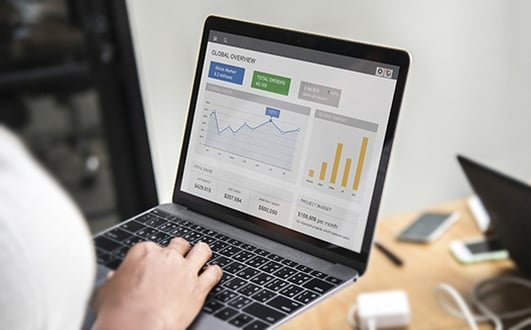![]()
Nowadays, there are plenty of interactive tools you can use to generate graphics and visualize data. They all have their own advantages and disadvantages that make them suitable for creating reports, depending on the nature of the data, your communication goals, and your audience.
According to the report “Dapresy 2017/18 Annual MR Technology Report,” Microsoft PowerPoint remains the most popular method for delivering market research results. Surprisingly, there was a marked uptick in its use between 2015 and 2016, though it decreased a bit in 2017.
While PowerPoint is an effective tool for creating presentations, there are other tools which are far more suitable for creative infographic visuals.
Interactive online tools
Some online tools stand out for the ease with which they manage information and for the interactive options they offer for data visualization. They make it possible to create dynamic infographics that are not only attractive, intuitive, and easy to use, but are also powerful tools for effective communication. And you don’t need any prior knowledge of design or programming to use them.
We researched four popular online interactive tools in order to judge their capabilities in visualization, publication/delivery, as well as judge their limitations. You can find the results in the table below.
| Canva | ||||
|
Visualization capabilities |
- Easy to design interactive infographics and create simple dashboards. - Offers a library of high-quality customizables graphics and charts. |
- A wide variety of graphics from a library with over 600 infographic templates and 1,000 icons.
|
- Helps effective communication by applying your brand’s style in different formats, including reports, ebooks, and infographics. - Open support in the form of graphic style guides and other resources. |
- Powerful and easy-to-use online tool. - Magic resize, change dimensions in any design with just one click. - Animations Pro function for infographic designs. - Automatic visual branding system in your designs with the function of brand kit. |
|
Publication and delivery / Sharing options |
- Easy to import data. - Option to embed URL design code in websites and on blogs.
|
- Flexible and intuitive process for importing data, exporting infographics, and printing right from the platform. - Download your infographic as an image (JPG, PNG), in HTML format, or as raw data. |
- Import data straight from your favourite tools, including Dropbox, Google Sheets, and WordPress. - Option to embed URL design code in websites and on blogs and social media. |
- Download infographic in PDF Print/ PNG/ JPG/ MP4/ GIF - Create teams to edit and share infographics. |
|
Limitations |
- Limits on the free public version. - New platform for creating more complex open-source graphics. - No advanced analysis tools. |
- Limited free version. - No advanced data analysis tools. - No API extensions to other open-source platforms. |
- Limited free version. - No advanced data analysis tools. |
- 30 days (trial period available). - No advanced data analysis tools. |
Each of these tools has it own advantages and disadvantages, but can all be used to easily create effective and understandable infographics. If you are interested in creating great infographics, you can read our free ebook all about data visualization by clicking the banner below.





